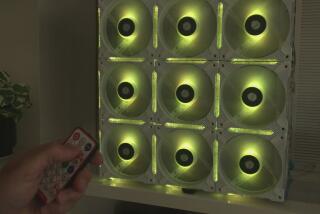With demand for air purifiers growing, here’s what to look for
- Share via
Last fall, Diane Nathanson, a Toluca Lake resident who is allergic to pollens and other airborne particles, bought an air purifier, thinking that it would also cut down on cooking smells and odor from the dog.
“But then I saw a Consumer Reports study that said the model I bought wasn’t very effective, so I took it back,” says Nathanson. “After that, I heard about the Living Air Flair on the radio. It was used at the Pentagon to clear the air after the 9/11 attacks, so I bought that. It does seem to help, but I don’t use it all the time because my husband doesn’t like the noise.”
Air pollution and allergies plague many in Southern California. At this time of year, Angelenos are facing the official end of the ozone smog season, and the rise of fine particulate pollution.
To combat this, consumers are increasingly turning to home air purifiers. According to the latest figures from Consumer Reports, concerns about pollution, allergies and terrorism spurred sales of 3.4 million units by consumers in 2002, up 70% from 2000.
The top-selling five brands of air purifiers, based on unit sales from July 2003 to June 2004, include Sharper Image’s Ionic Breeze, Holmes, Honeywell, Oreck and Hamilton Beach, according to NPD Group, a market research firm.
Air purifiers generally fall into three categories: HEPA filters, electronic cleaners (which include ion generators or ionizers), and hybrids, which use more than one filter to capture different sized particles in the air.
According to physicians and the American Lung Assn., air cleaners that use HEPA (high efficiency particulate air) filters are the most efficient and remove the smallest particles. They are used in hospitals and other areas that require clean indoor environments. Of the top five sellers, Holmes, Honeywell and Hamilton Beach offer HEPA models.
The most recent testing by Consumer Reports showed that overall, electronic cleaners were not very effective.
Dr. Michael Hirt, with the Center for Integrative Medicine in Tarzana, advises against buying electronic air purifiers that use ion generators or ionizers, which generate negatively charged ions. The ions act as a magnet for dust, which is then collected on a steel plate, or inadvertently adheres to other objects in the room.
“As soon as the charge wears off, the dust falls to the floor, and you’re surrounded by it again,” says Hirt. “More importantly, the ionization process creates ozone, which is an air pollutant and an oxidant. We take antioxidants to help counter the effect of oxidants on our bodies, so pumping ozone into your home potentially has a negative effect.”
Hirt says running an ion generator for short periods of time when no one is home is probably safe, but consumers should understand that the main purpose of doing so is to rid the house of odors, not to clean the air itself.
Bengt Rittri, president of Blueair Inc., which manufactures air purifiers with ion generators, says his products reduce the ozone in a room, and do not add to it.
“Our protective galvanized steel housing eats ozone, reducing and not adding ozone to the environment,” says Rittri.
Physicians note that even the best air purifiers don’t always help allergy sufferers.
“I recommend them, but it depends on the situation,” says Dr. Joseph Gaudencio Dizon, an allergy immunology specialist with Kaiser Permanente. “It’s good for dealing with pollens and molds that may be in the environment, or even for animal dander. But if someone’s allergic to dust mites, air purifiers are not that helpful because dust mites don’t tend to be airborne.”
More to Read
Inside the business of entertainment
The Wide Shot brings you news, analysis and insights on everything from streaming wars to production — and what it all means for the future.
You may occasionally receive promotional content from the Los Angeles Times.










